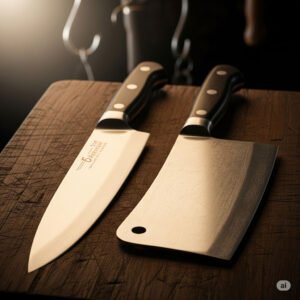A butcher knife is used for precision tasks like slicing, trimming fat, and navigating around bones. In contrast, a cleaver is a heavy, rectangular knife built for power. It’s designed to chop through tough bones, joints, and tendons, and can also be used to smash garlic or tenderize meat.
Choosing the right tool for the job is key to success, especially in the kitchen. When it comes to breaking down large cuts of meat, two heavy hitters often come to mind: the butcher knife and the meat cleaver. While they might seem similar at first glance, the butcher knife vs cleaver debate reveals that these tools are designed for very different purposes. Knowing the specific role each plays can help you work more efficiently and safely.
Let’s get into the details of these powerful knives. We’ll look at what makes each one unique, what they’re best for, and the key differences between them. By the time we’re done, you’ll know exactly which knife to grab, whether you’re working with a whole chicken or a big piece of beef.

Table of Contents
What Is a Butcher Knife?
A butcher knife, also known as a butcher’s breaking knife, is a kitchen workhorse designed for professional butchery. Its primary purpose is to break down large animal carcasses and separate primal cuts of meat. You’ll find it in the hands of butchers, hunters, and chefs who need to handle a lot of meat.
Butcher Knife Characteristics
- Blade Shape: The blade is typically long, with a distinct upward curve at the end. This curved shape allows for a smooth, rocking motion, making it easy to slice through meat and maneuver around bones. It often tapers to a sharp, pointed tip.
- Blade Length: Butcher knives usually have a blade length ranging from 6 to 14 inches. Longer blades are better for larger carcasses, providing more leverage and a longer cutting stroke.
- Weight: Butcher knives are generally lighter and more balanced than cleavers. This lighter build gives you better control and precision when slicing, trimming, and deboning.
- Sharpness: The edge of a butcher knife is sharpened to a finer angle, typically around 30 degrees. This allows it to be razor-sharp, ideal for clean slicing and separating meat from connective tissue.
Common Uses of a Butcher Knife
- Breaking Down Carcasses: Its main use is cutting large animal carcasses into smaller, more manageable pieces.
- Trimming and Slicing: The sharp, curved blade is perfect for trimming fat, silverskin, and slicing large roasts or briskets.
- De-boning: The pointed tip and flexible blade can be used to navigate around bones and joints to remove meat cleanly.
- Portioning: It’s excellent for cutting thick pieces of meat, like steaks or chops, into individual portions.
What Is a Meat Cleaver?
A meat cleaver is a large, heavy knife that looks more like a small ax. It is built for raw power and brute force. When you need to chop, hack, and split, a cleaver is the tool of choice.
Meat Cleaver Characteristics
- Blade Shape: A meat cleaver has a signature rectangular and wide blade. The shape is designed to deliver maximum impact with each swing.
- Blade Length: Cleaver blades are shorter than butcher knives, typically between 6 to 8 inches.
- Weight: Cleavers are heavy, often weighing between 1 and 3 pounds. This weight is crucial for its function, as the momentum and force from the heavy blade do most of the work.
- Sharpness: The edge of a cleaver is not as sharp as a butcher knife. It has a blunter edge angle, usually between 40 to 50 degrees. This less-sharp edge is tough and durable, designed to withstand the repeated impact of chopping through bone without chipping.
- Blade Thickness: Cleaver blades are noticeably thicker than butcher knives, which adds to their weight and resilience.
Common Uses of a Meat Cleaver
- Chopping Through Bone: Its primary use is chopping through bones, cartilage, and tendons. Think breaking down a whole chicken or lamb ribs.
- Splitting: The heavy blade can be used to split open tough, dense vegetables like winter squash or coconuts.
- Crushing: The flat, wide side of the blade is perfect for crushing garlic cloves or ginger.
- Tenderizing: You can use the back of the cleaver’s blade to pound and tenderize meat.
- Scooping: The broad blade acts as a convenient bench scraper to scoop up chopped ingredients and transfer them to a bowl or pan.
Comparison: Butcher Knife vs Cleaver
To truly understand which knife is right for you, let’s break down the main differences in a clear, easy-to-read chart.
Feature | Butcher Knife | Cleaver |
Primary Function | Slicing, trimming, de-boning | Chopping, hacking, splitting |
Blade Shape | Long, curved, pointed tip | Short, wide, rectangular |
Weight | Lighter, more balanced | Heavy, designed for momentum |
Blade Edge | Sharper (30-degree angle) | Blunter (40-50 degree angle) |
Blade Thickness | Thinner | Thicker |
Cutting Action | Slicing, sawing, carving | Chopping, pounding, smashing |
Best For | Portioning large cuts, trimming fat, de-boning | Chopping through bones and tough joints |
Common User | Butchers, hunters, chefs | Butchers, home cooks processing poultry |
Which Knife is Needed for Your Kitchen?
So, which knife is the winner in the butcher knife vs cleaver match-up? The answer is that neither is inherently “better.” It all comes down to the task you need to accomplish.
- Choose a Butcher Knife if… you often work with large roasts, briskets, or whole legs of lamb. Its longer, curved blade is perfect for making long, clean slices and navigating around bone to separate meat. If you need to trim, slice, and portion, this is your go-to blade.
- Choose a Cleaver if… you frequently chop through bones in poultry or pork ribs. The weight and force of the cleaver make quick work of hard tasks that would damage a regular knife. It’s the ideal tool for hacking and splitting with power.
For most home kitchens, a butcher knife offers more versatility for general meat preparation. However, if you’re a serious home cook who loves breaking down whole chickens or prepping bone-in meats, a cleaver is a powerful addition to your collection.
FAQ
Yes, a butcher knife can handle some smaller bones. However, its fine edge is not designed for the repeated impact of chopping hard bones. Using it for this task can chip or dull the blade.
While a cleaver can slice, its heavy, blunt blade makes it less efficient and precise than a butcher knife or a chef’s knife. It is not ideal for thin, delicate slices.
Is it the same as a meat cleaver? No, a Chinese cleaver is different. It is a lighter, thinner, and much sharper knife used as a versatile all-purpose tool for chopping vegetables, mincing, and slicing boneless meat. It should not be used for chopping through bones.
Because of its tough edge, a cleaver can be sharpened with a coarse whetstone or a sharpening rod. Honing the blade before each use is a good practice to maintain its edge.
Both knives require careful handling. However, the butcher knife’s slicing motion may feel more familiar to home cooks. The cleaver’s powerful, hacking motion requires practice to use safely and effectively.
Yes, a butcher knife can certainly cut through large, tough vegetables. However, for everyday vegetable prep, a chef’s knife is usually more suitable.
Not necessarily. While high-quality steel and proper construction are important, the most expensive knife may not be the best for your needs. Focus on finding a well-made knife that feels balanced and comfortable in your hand.
Conclusion
The butcher knife vs cleaver debate is a classic one. These knives are designed for two distinct purposes. The butcher knife excels at precise slicing and trimming, while the cleaver is built for pure chopping power. Understanding their differences is key to choosing the right tool. By selecting the correct knife for the task, you can achieve professional results and make your time in the kitchen more enjoyable and efficient.



